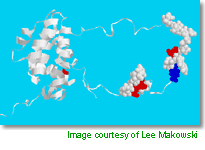 |
 To Expand Forever? To Expand Forever?
|
 |

NSF Telescope
Sheds Light on Fate of Universe
Researchers from Carnegie Mellon University,
using a National Science Foundation (NSF) microwave
telescope in Antarctica, have made a crucial measurement
of cosmic background radiation that may help science
to settle a fundamental question of whether the universe
will expand forever or collapse back upon itself.
Scientists measured the dimensions of extremely distant
gas clouds with the Viper Telescope, operated by the
Center for Astrophysical Research (CARA) in Antarctica
at NSF's Amundsen-Scott South Pole Station.
More...
|
 |

Serendipity:
Cell Structure Study Uncovers Taxol's Secrets
Scientists
funded by the National Science Foundation (NSF) have
learned exactly how the anti-cancer drug Taxol kills
tumor cells. Their new insight into Taxol, happened
upon during a study of molecular structures related
to cell division, may aid researchers in developing
more advanced cancer-fighting drugs. "It's a two-pronged
attack against cancer cells," said biophysicist Lee
Makowski. "Taxol keeps cells from dividing, which
halts cell growth, but then it also binds to molecules
of the Bcl-2 protein, which causes cell death."
More...
Image: This is a model for Bcl-2 based on the
structure of the homologous protein Bcl-XL. The residues
in space filling format are those with sequences showing
significant similarity to the peptides selected for
affinity to Taxol. The residues colored in red represent
the 4 sites found to be phosphorylated in cells treated
with Taxol (including two -70 and 74 - that appear
contiguous here). The residue rendered in blue is
a hot spot for mutations that render Bcl-2 resistant
to phosphorylation by Taxol. The proximity of sequences
expected to have high affinity for Taxol with those
that are affected in cells treated with Taxol suggests
that the phosphorylation and inactivation of Bcl-2
is mediated by direct interaction with Taxol.
|
 |

New, Low-Cost "GPS" Can Monitor Volcanoes, Faults
and Storms
The Global
Positioning System (GPS), which gives geologists the
ability to measure ground motions of less than an
inch, has proven to be an important tool for both
geophysical and atmospheric research. The high cost
(about $20,000) of GPS installations, however, has
limited their number, making it harder to study rapidly-changing
phenomena like volcanoes, faults, and weather. Now
researchers at the University NAVSTAR Consortium (UNAVCO),
an international organization of more than 80 universities
and other research institutions, have developed a
new high-precision GPS system. The system's cost is
low enough for it to be deployed in large numbers.
More...
|
 |

NSF-Funded
Research Heads Science Magazine's Top Ten Advances
of 1998
National
Science Foundation (NSF)-supported research led to
the two most important scientific advances in 1998,
according to a new Science magazine
summary of the ten discoveries it considered the most
important of the year. The list was released in the
December 18th edition. Two independent teams of NSF-supported
astronomers who concluded that the expansion of the
universe is accelerating were cited by Science
as having made the top scientific research advance
of 1998. The magazine also cited research in circadian
rhythms, the built-in mechanism most organisms on
Earth use to keep track of the 24-hour cycle between
night and day, as the second most important discovery
in 1998.
More...
|
 |
 
|

